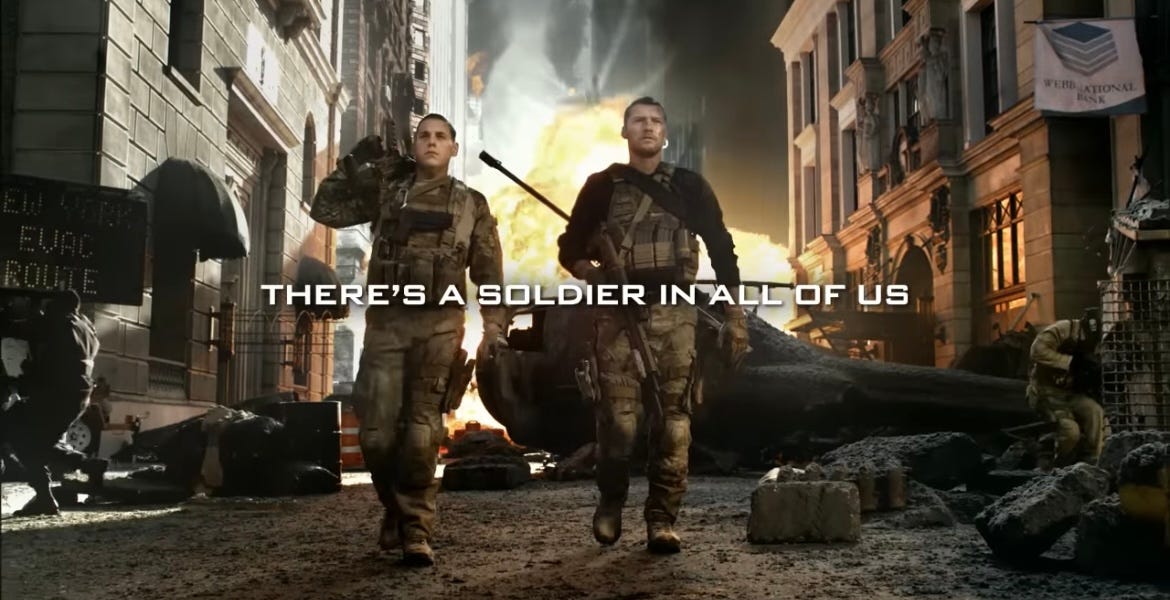American Bushido in Practice
Part II: Ukraine, Human Capital, and What it Actually Takes to Win “Big Boy” War
Secretary of Defense Rock
May 28, 2025
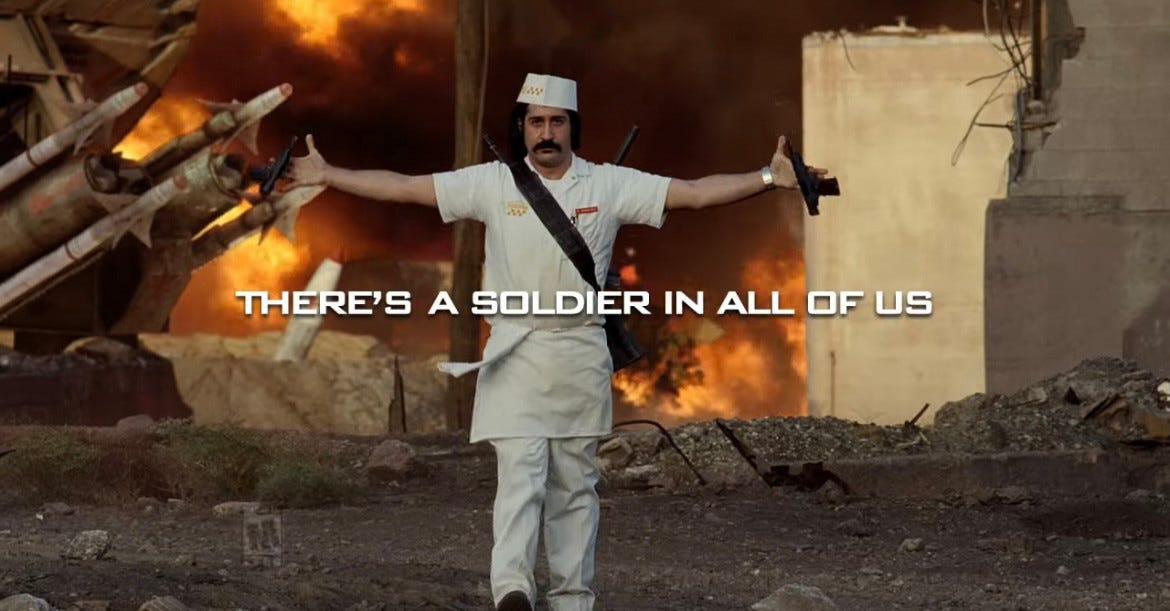
Since the post-9/11 era, U.S. military culture has been consumed with a singular ideal: the warfighter.
1 Tactical proficiency, elite units, and lethality became watchwords for military competence, fueled by twenty years of dominance in counterinsurgency and special operations. The archetype of the rugged, rifle-clad operator became not just a recruitment pitch, but a strategic fantasy; a belief that grit, gear, and guts can overcome any challenge. But the war in Ukraine has shattered this illusion. In its place, a different truth emerges: war, real war, "Big Boy War" as one Ukrainian soldier half-jokingly called his war, is a contest of national endurance, systems integration, and most critically, human capital.
2 It is fought and won not by a warrior elite alone but by citizen-soldiers, logistics officers, trench engineers, and the slow, grinding machinery of a mobilized society. The obsession with the warfighter has blinded the American military to the reality that modern war demands more than tactics; it demands a people prepared to endure and outlast.
At the end of the day, the warrior ethos, lethality, and grit, none of that will decide the outcome of a modern large-scale war. These concepts may shape morale and cohesion, but they are strategically secondary. The only things that truly matter in modern war are mass and logistics. Can you move enough men, machines, and munitions from point A to point B within a timeframe that aligns with operational demands?
3 Can you concentrate sufficient force at the decisive point to overwhelm the enemy and exploit the breakthrough before they can react consistently? And perhaps most importantly, can you do this not just at the start of a war, but six months in, a year in, when initial stockpiles have been depleted, equipment has been lost, and the industrial base is groaning under demand?
As it currently exists, the American military, technologically sophisticated, expeditionary, and elite-heavy, is ill-suited to fight and win a prolonged, attritional conflict against a peer adversary.
4 Yet, rather than asking, "How do we fight and win a war on an industrial scale?" the question has seemingly become, "How do we make our small force smaller and more deadly?"
5 That might work against insurgents or small rogue states. It will not work against adversaries who can take a punch and throw two back.
6
If, heaven forbid, the United States finds itself in a conflict with a near-peer adversary, the force that will be required to prevail will look hilariously different from the current one. It will be larger, more redundant, more integrated with civilian industry, and far more focused on sustaining mass over projecting finesse. This transformation isn’t theoretical; it’s a historical precedent.
7 The U.S. military that stormed across Europe and the Pacific in 1945 bore little resemblance to the modest, poorly equipped, and undermanned force that existed in 1941. It had undergone a total metamorphosis: from a tiny peacetime army into an industrial-age war machine that could land entire armies on foreign shores, field tens of thousands of tanks and aircraft, and keep them supplied across oceans and continents on multiple fronts. That shift wasn’t just about weapons; it was about institutions, doctrine, and the mobilization of a society as a whole.
In the same way, the force that will win the next great war will not be the sleek, boutique military that dominates current defense thinking. It will require an army of warehouses, trains, factories, ports, and planning tables, an ecosystem rather than a gladiator corps. It will win not by striking harder, but by enduring longer, replacing losses faster, and arriving first with the most.
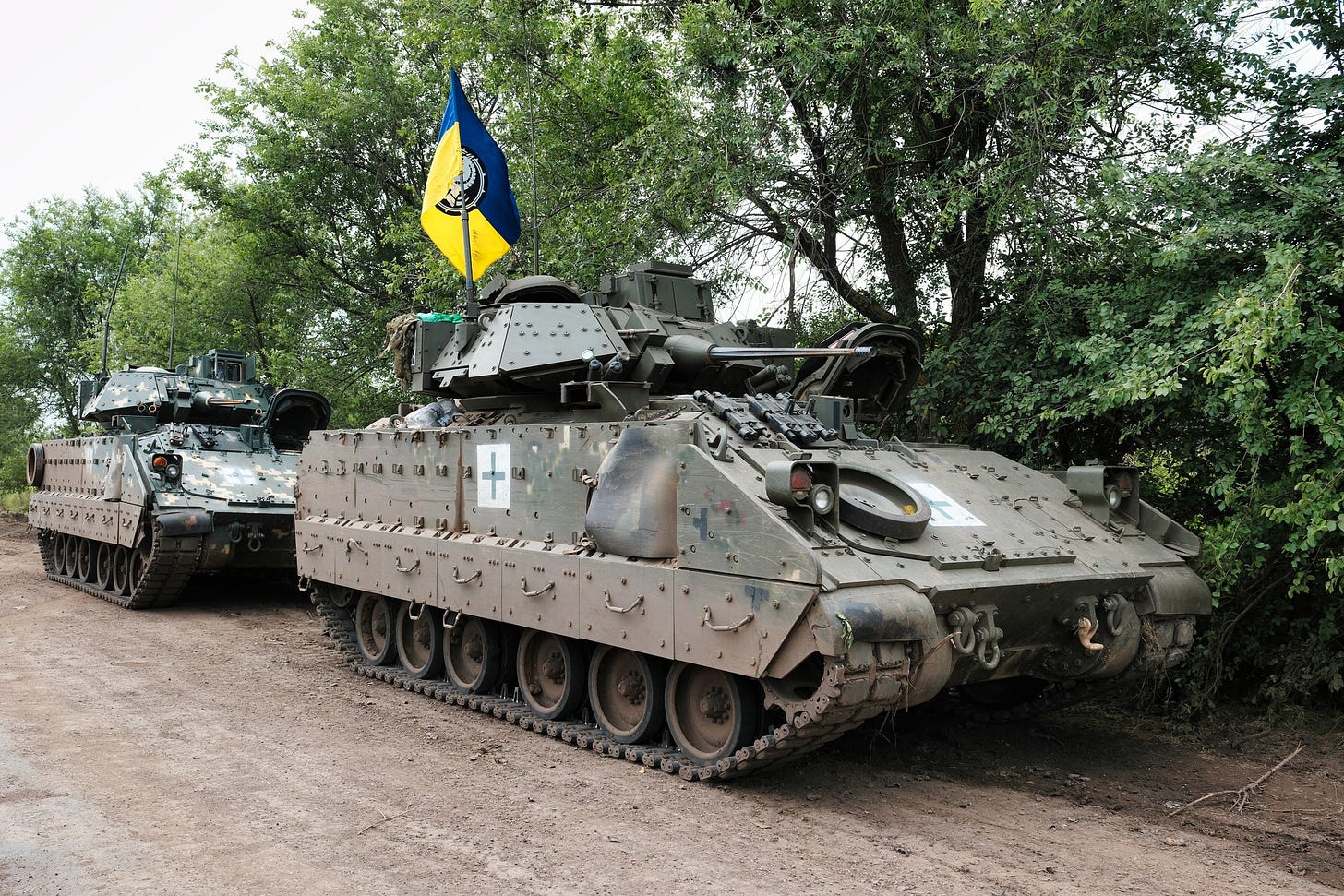 American Bradley’s in the service of the Ukrainian military
American Bradley’s in the service of the Ukrainian military
Ukraine's war has revealed the limits of America's preferred model of warfare. Despite receiving advanced Western weapons, Ukrainian brigades found themselves hampered not by a lack of lethality but by the inability to sustain complex combined-arms operations under constant fire. The myth that better gear and braver soldiers could crack entrenched defenses gave way to the realization that success requires something more mundane: scale, manpower, and institutional depth.
8
In the early phases of the 2023 Summer counteroffensive, newly trained Ukrainian brigades, equipped with NATO gear and tactics and many staffed with Western-trained non-commissioned officers and officers, ran headlong into Russia’s layered defensive zones. Ukrainian planners were instructed to execute a mechanized bum rush with only a third of the support NATO forces typically require: no air superiority, limited artillery, and fragile logistics. Unsurprisingly, the UAF was unable to compensate. Tactical proficiency is no substitute for depth. The casualties were immense, morale suffered, and the initiative eventually slipped.
9
This is not to suggest that armored vehicles or combined arms warfare have lost their value. On the contrary, the author maintains that a fully equipped Ukrainian military, bolstered by even functional air superiority, sufficient artillery, and robust logistical support, would have stood a far greater chance of achieving operational breakthroughs along multiple sectors of the front. The problem was never with the doctrine itself, but with the conditions under which it was applied. NATO-style combined arms maneuvering is built on the assumption of enablers that Ukraine never had: persistent air cover, deep stockpiles, and redundancy in manpower and machines. And yet somehow, one under-resourced, politically constrained, and ultimately partial attempt at executing air-land battle in Ukraine has somehow convinced an entire segment of the defense establishment that we should now pivot entirely to light infantry drone brigades, an idea driven less by operational necessity than by the commercial interests of defense-tech investors eager to shape the next procurement wave.
10
Moreover, the political dynamics of mobilization were inextricably tied to this deficit. President Zelensky and the Ukrainian parliament might have been far more willing to bear the social and political costs of expanding conscription to include the under-25 demographic, often seen as fragile, irreplaceable, or emblematic of national hope, if there was confidence that these newly drafted 18 or 19 year-olds would be entering battle in M2 Bradley’s or Leopard 2s, not rusting Soviet-era BMP-1s built when the Berlin Wall still stood. It’s one thing to ask a generation to sacrifice; it’s another to send them into war with equipment older than their parents. Without the promise of survivability, support, and proper armament, mobilization becomes not just a political risk but a moral hazard.
Unsurprisingly, American commentary publicly and privately has essentially defaulted to blaming Ukrainian leadership for being too cautious or too reckless, depending on who you ask.
11 Few seemed willing to accept the obvious: you cannot recreate the U.S. military’s effectiveness on paper and then subtract the hundred-thousand-person logistical base, overwhelming airpower, and the massive economy that finances it. That is not a failure of the Ukrainian soldier; it is a failure of Western imagination.
12
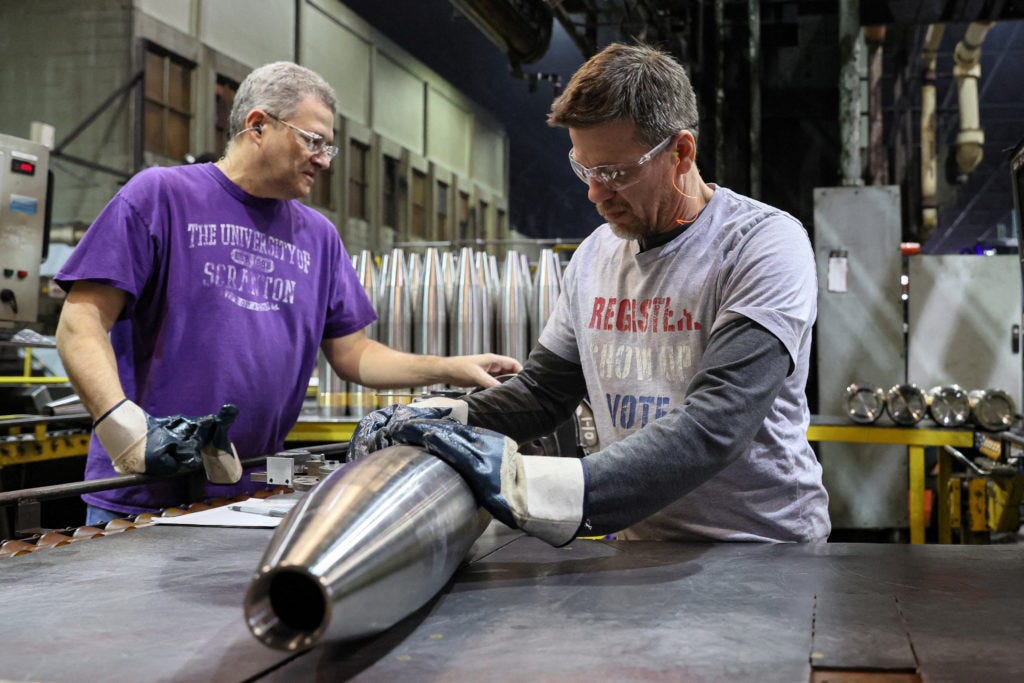 155 MM artillery Shells being manufactured in Scranton, PA.
155 MM artillery Shells being manufactured in Scranton, PA.
It’s a strange dichotomy because most people in the defense policy space recognize the problems, whether in the defense industrial base, force structure, or operational theory. Many even have workable solutions, and in some areas, real progress has been made.
13 For example, prior to the war in Ukraine, the U.S. was producing roughly 14,000 155 MM shells per month, the standard munition for artillery platforms.
14 This was a figure suitable for counterinsurgency operations but laughably inadequate for a high-intensity conflict. Recognizing the scale of artillery consumption in Ukraine, where tens of thousands of shells are fired daily, the United States has invested $3.1 billion in reviving and expanding its production infrastructure across the country, increasing capacity in several factories and building new plants from scratch in Alabama and Texas.
15 The results are beginning to show: by 2024, monthly output had increased to 40,000 shells, with current rates nearing 65,000. The target is to reach 100,000 shells per month by the end of 2026.
Yet despite this understanding and partial success, systemic change remains elusive. Elements within the current administration have begun to recognize that mass matters in modern warfare, but only in narrowly defined, technologically palatable ways. A notable example is the increasing emphasis on unmanned systems, particularly drones. Across various government and military leadership branches, there is an emerging consensus that large quantities of cheap, attritable drones are critical for modern battlefield success.
16 Ukraine’s success with first-person-view (FPV) drones and Russia’s success with fiber-optic drones have only reinforced this view. However, this shift is often misinterpreted as strategic innovation when, in reality, both Ukraine and Russia are heavily relying on different drones because they are short on artillery platforms and ammo, and neither side possesses the capacity to conduct large-scale strike warfare from the air, let alone integrate it meaningfully with ground maneuvers.
17
But this recognition remains highly compartmentalized. The value of mass is acknowledged when it involves drones, autonomous systems, or other tech-forward platforms that align with Silicon Valley defense startups, which supposedly require a minimal human footprint. In these areas, the rhetoric has shifted—terms like “drone swarms,” “massed ISR,” and “attritable autonomy” now pepper press releases, strategic documents, and congressional testimonies.
18 There is funding. There is enthusiasm. There is even urgency. Yet this same logic is rarely applied to the broader force. There is little comparable urgency when it comes to mass-producing ammunition, scaling up armored vehicle output (in fact, they’re supposedly cutting back), or examining personnel systems to handle a mobilization-level influx. Creating mass in the form of more infantry battalions, logistics regiments, or human sustainment infrastructure still feels alien.
The administration is willing to embrace mass when it’s silicon-based and software-coded, but remains hesitant when mass implies human beings in uniform, long supply lines, and steel-and-diesel solutions. The current force structure plan put forth by the Army secretary outlines reductions to “responsibly balance end strength” in pursuit of a “leaner, more lethal Army.”
19 This selective embrace of mass reveals a deeper problem: the desire to modernize warfare without confronting it in full. It’s a lot easier to imagine fleets of autonomous drones than it is to imagine a national conscription policy. And so we get an incomplete doctrine, one that accepts the logic of mass in one domain but avoids its implications in the others.
The Army’s current doctrine, Field Manual 3-0, emphasizes large-scale combat operations and multi-domain integration, while also considering reducing the force by 90,000 soldiers or eliminating a significant portion of its armor. It’s a contradiction that seemingly no one is entirely comfortable with answering because it would require asking all of American society to do something, not just a small group of professional volunteers. The operative word repeatedly cited in FM 3-0 is “operations,” a term that reflects the Army’s longstanding tendency to privilege the mechanics of battle over its meaning. This orientation underscores the fundamentally anti-Clausewitzian nature of the U.S. military. Rather than treating war as a political act conducted through violence, the military treats it as a series of operational problems to be solved with technology, precision, and maneuver. Strategy is often retrofitted onto operations, rather than shaping them from the outset. Clausewitz taught that the nature of war is determined by the political context in which it is waged, yet American campaigns, from Vietnam to Iraq to Afghanistan, repeatedly demonstrate an institutional inability to connect tactical and operational success with coherent political outcomes. FM 3-0 continues this tradition, offering sophisticated visions of battlefield integration while eliding the larger question of how any of it serves strategic objectives rooted in political necessity.
The most successful adaptations of the Ukraine war have come not from top-tier warriors but from bottom-up improvisation and the steady emergence of a mobilized citizenry. Ukraine's Territorial Defense Forces and national guard and police units, initially seen as a stopgap, have become indispensable. Reservists, teachers, IT workers, and farmers found themselves on the frontlines, digging trenches, operating drones, laying mines, and coordinating fire missions. They fought because they had to, not because they were lethal, but because they were committed.
20
Drone teams, often manned by civilians with no prior military experience, have become the most effective element of Ukraine's tactical ecosystem.
21 Not because they are elite, but because they are abundant, flexible, and creative. These small units have integrated commercial technology into persistent surveillance and strike platforms, compensating for a lack of traditional airpower. In a war of attrition, ingenuity and persistence matter far more than individual lethality.
22
Contrast this with Western military planning, which still fetishizes elite formations and boutique capabilities. Much of the U.S. defense budget is eaten up by small, expensive, high-maintenance platforms designed for force projection, not force absorption.
23 The idea of mass, a military capable of enduring loss, replacing personnel, and sustaining operations over years, has atrophied. Decades of professionalization have created a force that is tactically sharp but numerically shallow. Every serious analysis of a conflict with peer adversaries highlights attritional warfare and contested logistics, the military discovers that it cannot grow, train, or absorb losses at a sufficient rate.
24
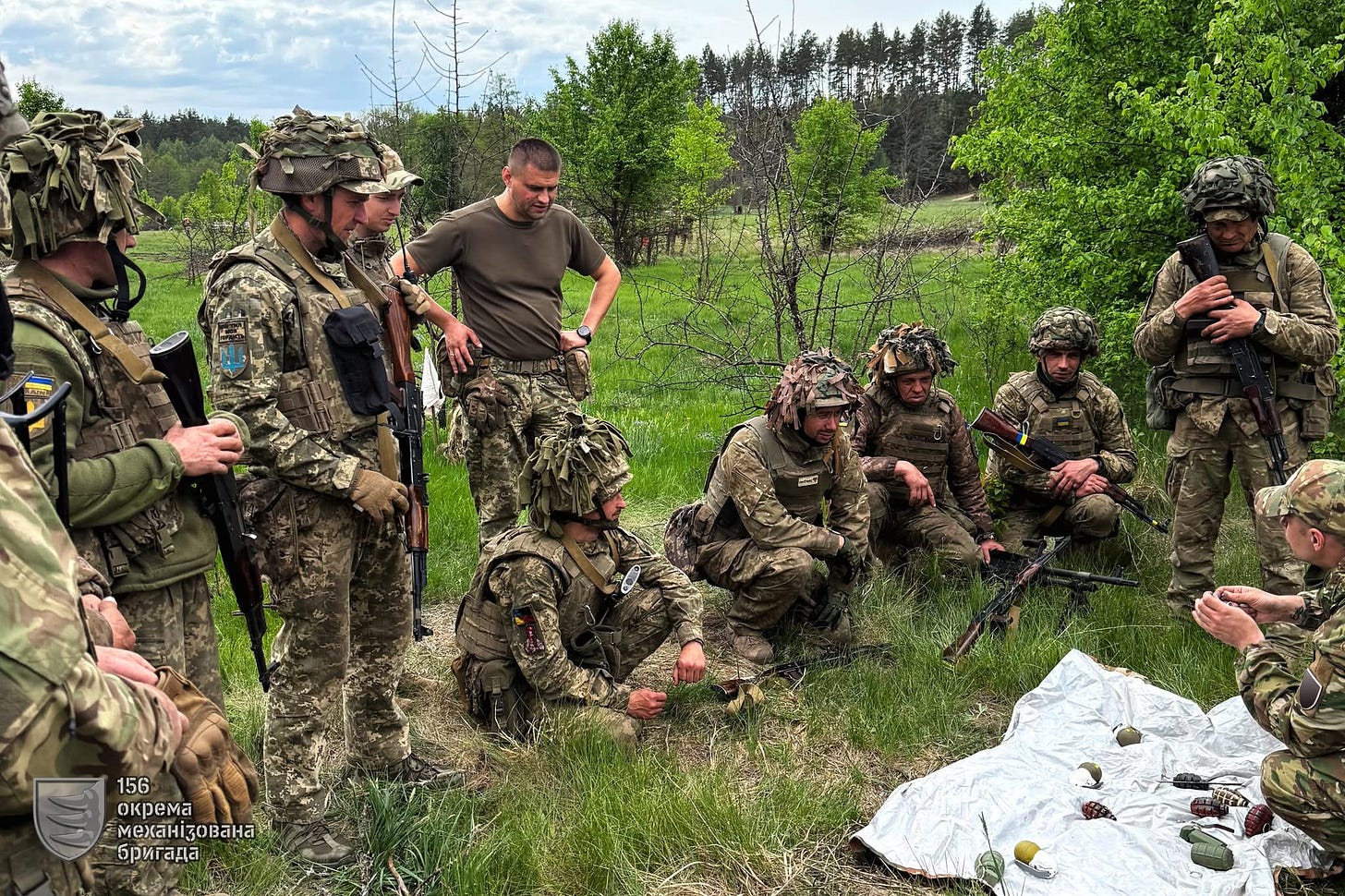 Drafted Soldiers from the 156th Mechanized Brigade in Training
Drafted Soldiers from the 156th Mechanized Brigade in Training
Ukraine, despite its systemic flaws, has mobilized hundreds of thousands across all sectors of society. That effort has not been without difficulty or controversy, but it has allowed Ukraine to sustain a war that would have broken smaller, more professionalized forces.
25 The Soviet-style reserve system that Kyiv inherited, outdated in many ways, proved more adaptable than many expected. More importantly, Ukraine’s societal mobilization has created an ecology of war effort: drone hobbyists, civilian logistics networks, local repair crews, and open-source intelligence volunteers. This is not a war of the professional elite. It is a war of the engaged citizen.
Ukraine has merely shown what war at scale is fundamentally about: manpower, logistics, production, and adaptation. “Lethality” matters, but only in context. A HIMARS strike means little if there are no drones to spot, no batteries to reload, no crews trained to fire. Killing one tank is good. Replacing the losses your side takes by doing so is better. Surviving the next phase of the war is the best course of action.
26
Meanwhile, the U.S. has structured its forces to avoid precisely this kind of war. There is no mechanism to surge personnel without years of preparation.
27 The military is a narrow slice of society, increasingly disconnected from the population it serves. When mobilization is discussed, it is often portrayed as a nightmare, rather than a necessity. But any future war with China, Russia, or even Iran will not be won by the warriors already in uniform. It will be won or lost by whether American society can actually produce the human capital required to sustain conflict.
28
What Ukraine has demonstrated, and what the American military must learn, is that endurance is a strategic asset. The side that adapts, replaces, sustains, and outlasts wins. That system must be expansive and inclusive. Citizen-soldiers, national service options, civil reserve fleets, industrial partnerships, and education programs must all be considered core elements of defense. A factory producing artillery shells in Scranton is as essential as a special operations team overseas. A software engineer coordinating logistics algorithms may do more to win a war than an infantry platoon. Big Boy War is not about who shoots best, but who shows up and keeps showing up the longest. Ukraine has become the test case for this 21st-century model of total war. Its successes have come from adaptation, not annihilation. Its endurance reflects not military perfection but societal resilience.
29
The next war will not be won by warfighters alone. Citizens will win it. By systems. By societies that can mobilize, adapt, and endure. The obsession with lethality and elite units is a legacy of a different era, a comfortable fantasy sustained by asymmetric wars and air superiority. But Big Boy War is back. And it does not care how many pushups you can do and how much you can lift. It cares if your army still exists after six months. It cares if your factories can retool in a week. It cares if your society believes in the fight.



